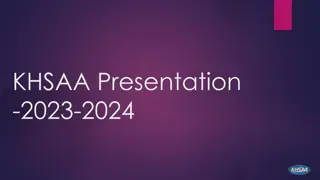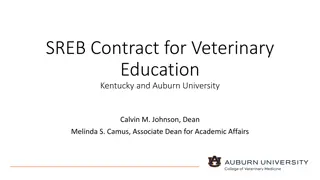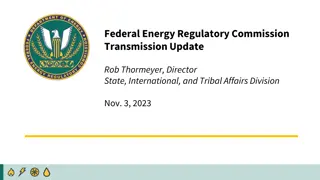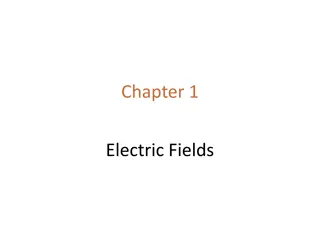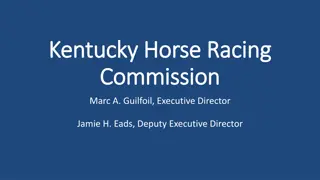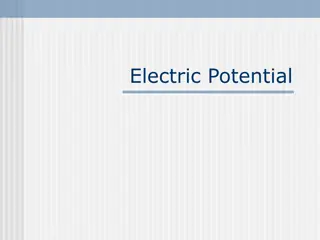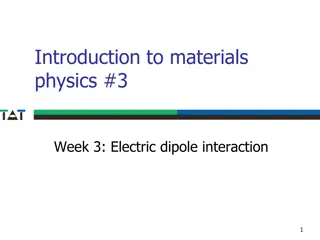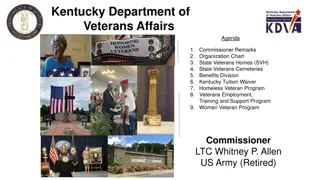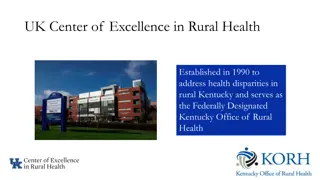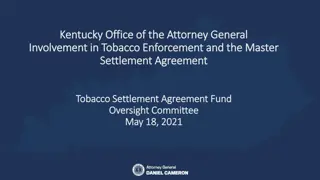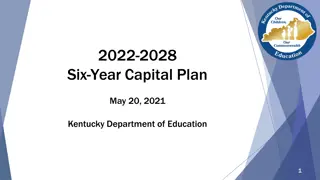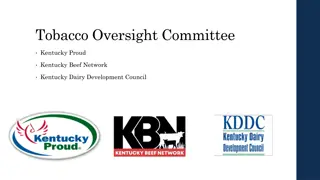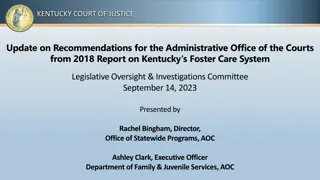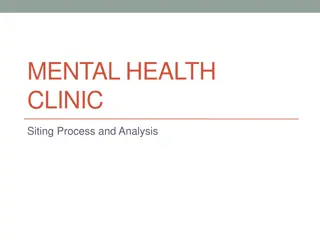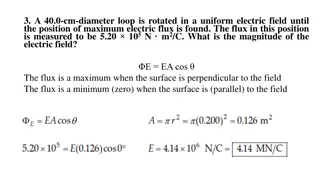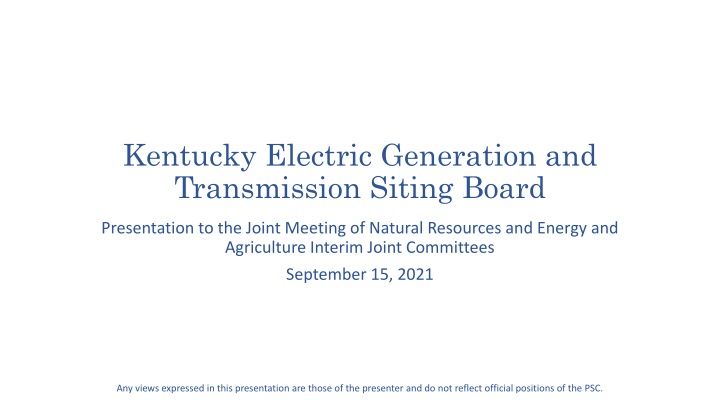
Kentucky Electric Generation and Transmission Siting Board
Kentucky Electric Generation and Transmission Siting Board presentation highlights PSC regulated entities, key terms, renewable energy initiatives, and the role of the Siting Board in reviewing merchant solar facilities. Learn about the board's composition, responsibilities, and focus areas for approving electric generating facilities and transmission lines.
Download Presentation

Please find below an Image/Link to download the presentation.
The content on the website is provided AS IS for your information and personal use only. It may not be sold, licensed, or shared on other websites without obtaining consent from the author. If you encounter any issues during the download, it is possible that the publisher has removed the file from their server.
You are allowed to download the files provided on this website for personal or commercial use, subject to the condition that they are used lawfully. All files are the property of their respective owners.
The content on the website is provided AS IS for your information and personal use only. It may not be sold, licensed, or shared on other websites without obtaining consent from the author.
E N D
Presentation Transcript
Kentucky Electric Generation and Transmission Siting Board Presentation to the Joint Meeting of Natural Resources and Energy and Agriculture Interim Joint Committees September 15, 2021 Any views expressed in this presentation are those of the presenter and do not reflect official positions of the PSC.
PSC Regulated Entities 1,100 jurisdictional utilities: Water and sewer utilities (small systems comprise the bulk of regulated utilities) Natural gas distribution systems and intrastate pipelines Electric utilities (investor-owned and jurisdictional cooperatives) Telecommunications Do not include municipal utilities except for gas pipeline safety. Do not include cooperatives served by TVA. The mission of the Kentucky Public Service Commission is to foster the provision of safe and reliable service at a reasonable price to the customers of jurisdictional utilities while providing for the financial stability of those utilities by setting fair and just rates, and supporting their operational competence by overseeing regulated activities. 2
Todays Key Terms MW= Megawatt How much electricity can be produced by a facility 1 Megawatt can power about 750 homes Merchant Generator= generation facility not owned by a utility IRB= Industrial Revenue Bonds Decommissioning= Returning land back to its original condition, regardless of depth, except for major moved earth and roads Kentucky State Board on Electric Generation and Transmission Siting= Siting Board 3
Renewable Energy in the Commonwealth 4
Merchant Solar Facilitiesthe Siting Board Created in 2002 with very few changes since Reviews applications and grants certificates if approved for the construction of electric generating facilities (i.e., merchant generators) greater than 10 MW and transmission lines from entities not regulated by the PSC. Review focuses on such factors as noise and visual impacts; economic impacts; and potential impact on transmission lines within the state. Attached to the PSC and staffed by PSC staff Operations are funded through fees paid by applicants 5
Siting Board Members Three members of the PSC Secretary of the Energy and Environment Cabinet or a designee/proxy Secretary of the Cabinet for Econ. Development or a designee/proxy Two local members, with one appointed by the Governor to serve for a specific case Ordinarily Judge/Executive or chair of P & Z is one member 6
Solar Generation Can be used to serve Ky. entities or out of state entities/markets For out of state, the facilities can serve specific customers or specific utilities, or no one in particular Kentucky has multiple markets/grids KU/LG&E (including municipalities) TVA (to the South) PJM (to the North and East) MISO(to the West) 8
Siting Board Process- Before filing application 90 days before application is filed, applicant must conduct local public meeting Public notice 2 weeks before local public meeting, at a minimum, must be provided to: General public via newspaper Bordering landowners by mail Additional public involvement program activities via other media coverage, direct mailing, fliers, newsletter, additional public meeting, etc. can be conducted At least 30 days before application, applicant must file notice with PSC/Siting Board with pertinent information, such as the location and whether P&Z applies 30 days before application, applicant must provide public notice of the location and a general description of the project to: General public (in newspaper) Bordering landowners 9
Siting Board Process- After filing application Ad hoc members are placed on the Siting Board for that project Local member appointed by Governor Statutory member (planning and zoning chair, Judge/Executive, mayor, etc.) provided notice by Siting Board staff Application fee filed ($1,000 per megawatt, with min. $40,000 and maximum $200,000) Procedural schedule entered allowing for: Deadline for motions to intervene Two rounds of discovery Date for the Siting Board consultant s report to be filed Applicant's response to consultant s report Evidentiary Hearing By statute, Siting Board has 120 days to render a final order, or 180 days after application is filed if an evidentiary hearing is held. 10
Siting Board Considerations- Site Assessment Report Per KRS 278.708, the applicant completes a Site Assessment Report that is to include: A description of the proposed facility, which is to include a proposed site development plan that describes: Surrounding land uses for residential, commercial, agricultural, and recreational purposes; The legal boundaries of the proposed site; Proposed access control to the site; The location of the facility, buildings, transmission lines, and other structures; Location and use of access ways, internal roads, and railways; Existing or proposed utilities to service the facility; Compliance with applicable setback requirements as provided under KRS 278.704(2), (3), (4), or (5); and Evaluation of the noise levels expected to be produced by the facility. 11
Siting Board Considerations- Site Assessment Report (continued) The Site Assessment Report also must include: An evaluation of the compatibility of the facility with scenic surroundings; The potential changes in property values and land use resulting from the siting, construction, and operation of the proposed facility for property owners adjacent to the facility; Evaluation of anticipated peak and average noise levels associated with the facility s construction and operation at the property boundary; and The impact of the facility s operation on road and rail traffic to and within the facility, including anticipated levels of fugitive dust created by the traffic and any anticipated degradation of roads and lands in the vicinity of the facility. 12
Issues In Recent Cases Statutory Set back Without P & Z, current 2000 foot setback from neighborhood, school, hospital or nursing home and facilities used for generating electricity Siting Boards have granted reasonable deviations Tax Revenue/Economic Impact Industrial Revenue Bonds School Taxes Property taxes Noise- abatement methods at construction and operation Viewshed- mitigation for benefit of surrounding properties Impact on PSC Decommissioning Plans and bonding 13
Best Practices Decommissioning Bonding Set Backs to neighborhoods, hospitals, etc. Distance to homes and neighboring property of non-participating and participating individuals Viewshed mitigation IRBs Ordinance and Conditional Use Permits Henderson and Madison County 14

